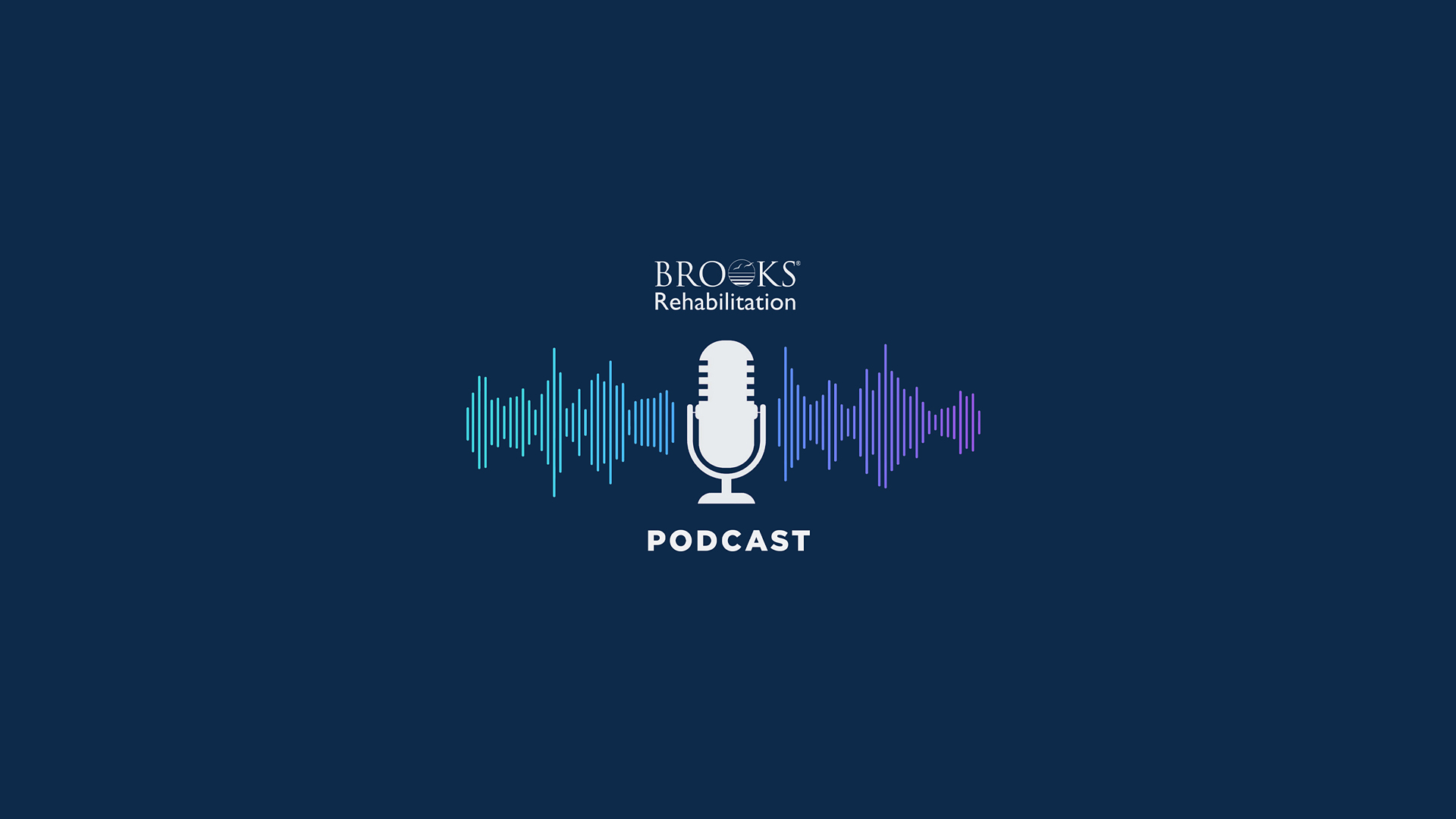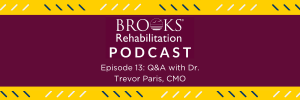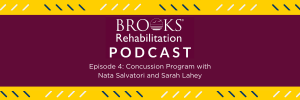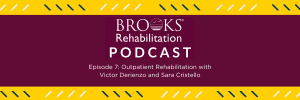Podcast | Episode: 23 Brooks Brain Injury Clubhouse

Back to physical health resource hub
Welcome to the Brooks Rehabilitation podcast where we talk with our rehabilitation professionals and shed light on the stellar programs and services we offer to help our patients reach their highest levels of recovery.
In this episode, we speak with Kathy Martin and Mona Taylor-Gordon about the Brooks Brain Injury Clubhouse.
Send us an email with your questions, comments or podcast ideas to [email protected]!
Listen to the full episode on your favorite podcast app! Search ‘Brooks Rehabilitation Podcast.’ You can also listen online. Below is a transcript of our newest episode.
Podcast Episode 23
Brooks Brain Injury Clubhouse Interview Transcript
Tracy Davis
Welcome to the Brooks Rehabilitation Podcast. My name is Tracy Davis. On this episode, we’re going to be talking about the Brooks Brain Injury Clubhouse which has been around for a long time since 2008. We’re going to get into the story of where it came from, where the idea came from, and some of the day to day and the things that they offer. And I want to thank Mona and Kathy for coming on and talking to us about it.
Before we get into the episode, I wanted to mention brooksrehab.org. If you’re curious about any programs, service, community programs, our research, everything that we have at Brooks, you’re going to find it on brooks rehab.org. And please follow us on social media. Just look for @BrooksRehab on your favorite social platform. With that, let’s get right into the episode. Thanks for joining me on the podcast today. Let’s start with introducing yourselves.
Kathy Martin:
Yeah, I’m Kathy Martin, and I’ve been with Brooks for about 34 years now.
Tracy Davis:
Mona?
Mona Gordon:
And I’m Mona Gordon, and I’ve been with Brooks for about 16 years now.
Tracy Davis:
Wow. Yeah, because I remember both of you guys from long time ago.
Mona Gordon:
Yeah.
Tracy Davis:
So when did this clubhouse start? What year was it?
Kathy Martin:
It was October of 2008.
Tracy Davis:
That’s right. Okay. Because I was over there at Healthcare Plaza in ’05, and I kind of remember when this started. So let’s just jump into that and maybe let’s start with a little bit of your background. Kathy, what is your background?
Kathy Martin:
I was a cognitive rehabilitation therapist. I started working in 1984 in the first day treatment program in the state of Florida, and that was in Orlando. And then in ’89, I came to the Jacksonville area and went to UNF to get a master’s degree in special education with a focus on disability services. And I did my internship at what was then Memorial Rehabilitation, but is now Brooks Rehabilitation. And immediately after I graduated, I was brought on full-time as a cognitive rehabilitation therapist.
Tracy Davis:
Mona?
Mona Gordon:
My background is… Actually, Brooks is my first job that I got after I moved to Jacksonville-
Tracy Davis:
Oh, wow.
Mona Gordon:
… in 2006. I haven’t had another job anywhere else. And I started out as an FDC and wanted to move to patient care. And I have a massage therapy background which allowed me to do that.
Tracy Davis:
Right.
Mona Gordon:
And eventually ended up in behavioral medicine with Kathy. She came over and wanted someone to help her serve lunch and run an exercise class, and I volunteered to do it. And that was right around the time that she was opening the clubhouse. And so as she was transitioning out of behavioral medicine, I was kind of transitioning into behavioral medicine as a rehab tech. And so I stayed there for a couple years. And when Kathy was able to hire someone full time, she reached out and I came to the clubhouse in 2011.
Tracy Davis:
Tell me about how the clubhouse started. Where did the idea come from? How did you see the need arising?
Kathy Martin:
So I had been with the day treatment program for about 14 years, and as time has gone by the window for receiving outpatient therapies has just gotten smaller and smaller. And we were having to discharge people, not because they were ready for discharge, but because insurance was limited. And we would have a little celebration and party and give them a certificate and applaud them for their graduation. But I knew very well that the future for most of these folks was going to be very bleak. There’s really no services to support the lifelong living needs of individuals with a brain injury. And so I took the concept and wrote a proposal to the administration at Brooks, and they immediately saw the need. And within the next year and a half we opened.
Tracy Davis:
Is there any kind of a model that you were already basing it off of that you had seen be successful somewhere else in the country? How did that work?
Kathy Martin:
Yeah. Back in the ’90, I would say, I was at a conference and the title of one of the presentations was Lifelong Living Following Brain Injury. And it was presented by the fellow who really was the originator of what are called ABI clubhouses. And ABI is acquired brain injury. So I very much connected with what he had to say about the need. And the model is originally from the Clubhouse International, and it’s by and for people with a mental health disorder. And that originated in New York, and I don’t know, I want to say the ’60s. And so they applied those standards to folks with a brain injury or ABI clubhouses, and now there’s an organization called the International Brain Injury Clubhouse Alliance.
Tracy Davis:
That’s great.
Kathy Martin:
Yeah. And so I follow the standards. There’s 34 standards that govern clubhouse operations, and we’re one of 17 that exists worldwide. And there’s only us, the Brooks Clubhouse, in Florida. It’s the one and only.
Tracy Davis:
Oh, wow. I didn’t know that. That’s great. So let’s get into the day-to-day of the clubhouse. What’s a day-to-day here? How much has it changed over the years? Obviously you got a lot of members here. What’s it been like over the years?
Kathy Martin:
Well, it’s been very productive over the years. We’ve served the needs of hundreds of individuals. I will call it a structured unstructured day. We have a schedule that we have every day. It doesn’t necessarily go as planned every day, but we start at 9:30 and we have a community meeting, and then we go into our work units. There’s the culinary work unit, the business office, and the maintenance, and they do the respective jobs in all of those areas. The model is one where the members and the staff work side by side for completion of all the daily operational needs. And then following completion of all of our task and our work units, there’s on the hour classes/groups, things like yoga, creative dance movement, art, music therapy.
Tracy Davis:
And they’re going out and about too, right?
Kathy Martin:
Yes. So we have people, professionals who come in and teach some classes here. And then in addition to that, we do as much community outings as we can.
Tracy Davis:
Sure.
Kathy Martin:
For example, this week we did adaptive cycling. We partnered with the Adaptive Sports and Recreation Program on that. And we also went and saw a movie. So we tried to get out as much as we possibly can. When COVID hit, things had to change pretty dramatically in terms of where we went and what we did and how many people we could serve. But we’re slowly getting back to our more normal routine.
Tracy Davis:
From your perspective, Mona, what’s a day-to-day like and what exactly do you do here as well?
Mona Gordon:
Well, I am the business unit coordinator, and so I help the members who want to get back online if they want to get back on social media, go back to their emails, that type of thing. But we also have programs on the computer that help them with memory language in different areas where they may see a deficit.
Tracy Davis:
Sure.
Mona Gordon:
So we have a member that does our weekly newsletter. We have members that come in and they will create flyers or whatever we need if we’re having closures and such.
Tracy Davis:
So they’re helping out with the day-to-day operations around?
Mona Gordon:
Absolutely.
Tracy Davis:
Yep. Absolutely.
Mona Gordon:
Absolutely.
Tracy Davis:
Yeah.
Mona Gordon:
And I have a member that also answers our phone during the day which is a big help to have someone doing that. And he really takes his job seriously. He loves doing that.
Tracy Davis:
That’s great.
Mona Gordon:
So we have that. But really the main thing, even in all of the work units, it is us working side by side with the members and helping them have a productive day.
Tracy Davis:
Right. Yeah. Okay. It’s great that you’re able to use the clubhouse as a way of working here as well, getting them back in the workforce. That’s great. So tell me about just some of the members here, the different levels of the members that you have here. I know it’s changed. It’s constantly different and going up and down.
Kathy Martin:
On the average day, we probably have about 21 members, but that means on some days there’s 25, 26 members here and other days there’s less. There is tremendous variety and diversity in terms of the individuals that attend, the nature of their injuries, as well as the nature of the impact or the sequela from their brain injuries. So we have folks who have no physical limitations whatsoever, but they may have cognitive and/or behavioral involvement. And we have members who have very minimal cognitive and involvement, but their physical functioning is greatly impacted. Have several members who are wheelchair users. And one of the criteria for admission is that people have to be independent and safe without one-on-one supervision or come with an attendant. So we have several members who have a daily attendant that can help them with things like eating or toileting or whatever their individual needs might be.
Tracy Davis:
Okay. Great. And what other units do you have? So you got the business unit, what all the units that you have here at the Clubhouse?
Kathy Martin:
We also have the maintenance work unit, and they’re responsible for all the general housekeeping and light outdoor, running the blower out there.
Tracy Davis:
They were just outside cleaning as I was coming back in.
Kathy Martin:
Okay. Yeah, yeah. And then we also have the culinary, and they do the meal planning, shopping, preparation, serving and clean up every day. Serve as a full course lunch. It’s only $2 for our members. And so the members here get to have a nice healthy lunch every day. And we also do a lot of product production where we make arts and crafts and we sell those during different holidays, and we do real well with that. And the profits from that go into the community fund for our membership which means we can pay for things like going out to lunch or movies. And a lot of our members on very tight, limited budget and couldn’t afford to do those things otherwise.
Tracy Davis:
Sure. Talk a little bit about maybe the sense of community that a lot of the people feel here, and I’m sure that it’s one of the most important things, if not the most important thing to the clubhouse. Mona, do you want to start?
Mona Gordon:
Yes. I look at the clubhouse and I think of family. The members come in and they act like they’re brother and sister and have just a close relationship with each other. But also it’s just the community of the clubhouse where as Kathy was speaking about the different levels that the members are at, it’s really endearing to see some of the higher functioning members help the lower functioning members. And it’s not because they feel like they have to, it’s that they want to help and they want the ones that are more impaired, they want them to have a good day. They want them to be involved. They want them to have the same experience that they’re having.
Tracy Davis:
Take advantage of their time here.
Mona Gordon:
Absolutely. And so it’s a family atmosphere.
Tracy Davis:
Mm-hmm.
Mona Gordon:
Very much so.
Tracy Davis:
Yeah. That’s great. And then you guys have, I’m sure, from the top down are making that culture here. I mean, it’s important that you guys are always encouraging that around here, I’m sure, so it doesn’t just come out of nowhere. And then can anybody come for lunch?
Kathy Martin:
Sure. We like to have a little notice on when people do come in, but we’ve hosted a number of people from the hospital and different departments to celebrate whatever event it might be. For outside folks that come for lunch, there’s only a $5 charge and that includes everything. And as I said, our members only pay $2. Our fees are on a sliding fee scale based on household income, and most people qualify for the $10 a day rate. And it goes up in increments of $10 to a maximum of $50.
Tracy Davis:
That’s great. And tell people about the building, the actual facility a little bit. I know it was in a different place before. Go ahead.
Mona Gordon:
So we were previously over on Cortez Road. That’s where I started at the Clubhouse. And I guess you can say fortunately, and unfortunately our program grew. You don’t want people to get traumatic brain injuries, but they come to us and they’re looking for us. They seek us out because there is such a need in the community for a program like this. So in 2016, because we had grown our senses so much, we needed more space, which brought us here to University Boulevard. I mean to other clubhouses, we have the Taj Mahal Clubhouses.
Tracy Davis:
Yeah, you got a lot of rooms, kitchen.
Mona Gordon:
Yes.
Tracy Davis:
Full kitchen, I mean it’s a lot.
Mona Gordon:
The commercial kitchen.
Tracy Davis:
We’re sitting in the business center now with the computers
Mona Gordon:
Yep. And then in the maintenance and product production area, they have everything that they need to do, a host of different projects. We also have the vocational area where when we help people get jobs, they have a place to go and do resumes and that type of thing. So I think the members enjoy just having the different areas, including the rec room. Now where we do exercise. We have a member actually that runs the exercise class.
Tracy Davis:
I’ve met him. Yah.
Mona Gordon:
Yeah. And he is wonderful. He has just come in and that’s one of his passions is teaching exercise. And he was a coach, so he’s just taken on that role with our members and they love it.
Tracy Davis:
That’s excellent. Yeah.
Mona Gordon:
He gives a MVP award every week, and I should say a fat gold chain with MVP on it and just that recognition. Otherwise, sometimes they wouldn’t get recognition, but they are getting and they love it.
Tracy Davis:
That’s awesome.
Mona Gordon:
Yeah.
Tracy Davis:
What else do you want people to know about the clubhouse that we didn’t talk about?
Kathy Martin:
Well, Mona had mentioned the vocational area. So there are two tracks of the program. One is the vocational and the other is the community reintegration. And in the vocational track, we get referrals from the State Department of Vocational Rehabilitation. And it’s our goal to find them appropriate work in the community and to help them learn the job, to provide services such as resume production, helping with online applications, helping them go through an interview if need be, attending the interview, as well as going on the job site and providing job coaching until they’re comfortable with what they’re doing-
Tracy Davis:
Oh, that’s great.
Kathy Martin:
… and able to perform the job adequately.
Tracy Davis:
Mm-hmm. Okay. Yeah. I mean, it’s amazing work that you guys are doing here just like all of our community programs at Brooks. It’s unbelievable. So anything else you wanted to say before we wrap up? What you want to say about the clubhouse?
Kathy Martin:
Well, we have a little motto here that nobody can do everything, but everybody can do something and that’s important-
Tracy Davis:
That’s great.
Kathy Martin:
… because everybody makes a very valuable contribution. And without the clubhouse, most of our members would be sitting home, idly watching TV, sleeping all day. A lot of folks can’t drive after their brain injuries, family goes back to work, friends fall by the wayside. So we provide a very critical and valued social integration and sense of productivity, and also just enjoyment and have fun. Our goal every day is to have fun and be productive.
Tracy Davis:
I mean, every time I come here, and I’ve been here many times, I can see you guys are having a great time and it’s a great environment to be around. Everyone’s very friendly and family oriented, so just like you guys said. So we can end it there. I thank you for your time. I really appreciate you guys coming on the Brooks podcast. Sorry, it’s long overdue.
Mona Gordon:
Thank you.
Kathy Martin:
I thank you, Tracy, for coming in and inquiring about our wonderful program. It’s great to be able to share the details.
Tracy Davis:
Yeah. And if anybody wants more information about the clubhouse, I’ll put it in the description for the podcast, a link to the website.
Kathy Martin:
Perfect.
Tracy Davis:
Yep. Thank you.


